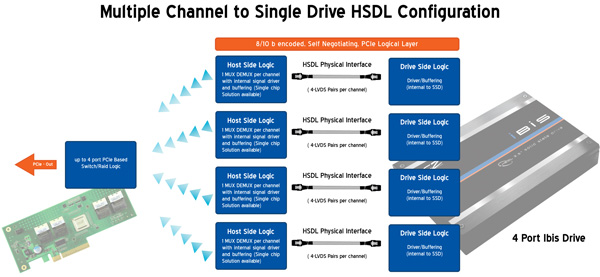OCZ's Fastest SSD, The IBIS and HSDL Interface Reviewed
by Anand Lal Shimpi on September 29, 2010 12:01 AM ESTThe Vision
I spoke with OCZ’s CEO Ryan Petersen and he outlined his vision for me. He wants HSDL and associated controllers to be present on motherboards. Instead of using PCIe SSDs, you’ll have HSDL connectors that can give you the bandwidth of PCIe. Instead of being limited to 3Gbps or 6Gbps as is the case with SATA/SAS today you get gobs of bandwidth. We’re talking 2GB/s of bandwidth per drive (1GB/s up and 1GB/s down) on a PCIe 2.0 motherboard. To feed that sort of bandwidth all OCZ has to do is RAID more SSD controllers internal to each drive (or move to faster drive controllers). Eventually, if HSDL takes off, controller makers wouldn’t have to target SATA they could simply build native PCIe controllers. It’d shave off some component cost and some latency.

You can even have a multi-port IBIS drive
The real win for HSDL appears to be the high end workstation or server markets. The single port HSDL/IBIS solution is interesting for those who want a lot of performance in a single drive, but honestly you could roll your own with a RAID controller and four SandForce drives for less money. The potential is once you start designing systems with multiple IBIS drives. With four of these drives you should be able to push multiple gigabytes per second of data which is just unheard of in something that’s still relatively attainable.
The Test
Note our AnandTech Storage Bench doesn't always play well with RAIDed drives and thus we weren't able to run it on the IBIS.
| CPU | Intel Core i7 975 running at 3.33GHz (Turbo & EIST Disabled) |
| Motherboard: | Intel DX58SO (Intel X58) |
| Chipset: | Intel X58 + Marvell SATA 6Gbps PCIe |
| Chipset Drivers: | Intel 9.1.1.1015 + Intel IMSM 8.9 |
| Memory: | Qimonda DDR3-1333 4 x 1GB (7-7-7-20) |
| Video Card: | eVGA GeForce GTX 285 |
| Video Drivers: | NVIDIA ForceWare 190.38 64-bit |
| Desktop Resolution: | 1920 x 1200 |
| OS: | Windows 7 x64 |










74 Comments
View All Comments
clovis501 - Wednesday, September 29, 2010 - link
If this innovation will eventually make it's way down to personal computer, it could simplify board design by allowing us to do away with the ever-changing SATA standard. A PCI Bus for all drives, and so much bandwidth than any bus-level bottleneck would be a thing of the past. One Bus to rule them all!LancerVI - Wednesday, September 29, 2010 - link
One bus to rule them all! That's a great point. One can hope. That would be great!AstroGuardian - Wednesday, September 29, 2010 - link
I want AT to how me how long will it take to install Windows 7 from a fast USB stick, install all the biggest and IO hungry apps. Then i want to see how long will it take to start them all @ the same time having been put in the Start-up folder. Then i want to see how well would work 5 virtual machines doing some synthetic benchmarks (each one @ the same time) under windows 7.Than i will have a clear view of how fast these SSD monsters are.
Minion4Hire - Wednesday, September 29, 2010 - link
Well aren't you demanding... =pPerisphetic - Thursday, September 30, 2010 - link
...or the past.Well it's probably deja vu, sounds like it.
This is exactly what the MCA (Micro Channel architecture) bus did.back in the day. My IBM PS/2 35 SX's hard drive connected directly to this bus which was also the way the plug in cards connected...
jonup - Wednesday, September 29, 2010 - link
"Even our upcoming server upgrade uses no less than fifty two SSDs across our entire network, and we’re small beans in the grand scheme of things."That's why the prices of SSD stay so high. The demand on the server market is way to high. Manufacturers do not need to fight for the mainstream consumer.
mckirkus - Wednesday, September 29, 2010 - link
I hate to feed trolls but this one is so easy to refute...The uptake of SSDs in the enterprise ultimately makes them cheaper/faster for consumers. If demand increases so does production. Also enterprise users buy different drives, the tech from those fancy beasts typically ends up in consumer products.
The analogy is that big car manufacturers have race teams for bleeding edge tech. If Anand bought a bunch of track ready Ferraris it wouldn't make your Toyota Yaris more expensive.
Flash production will ramp up to meet demand. Econ 101.
jonup - Wednesday, September 29, 2010 - link
Except that there is a limited supply of NAND Flash supply is limited while the demand for Ferraris does affect the demand for Yarises. Further, advances in technologies does not have anything to do with the shortage for Flash. Still further, supply for flash is very inelastic due to the high cost of entry and possibly limited supply of raw materials (read silicon).p.s. Do yourself a favor, do not teach me economics.
jonup - Wednesday, September 29, 2010 - link
Sorry for the bump, but in my original massage I simply expressed my supprise. I was not aware of the fact that SSD are so widely available/used in the commercial side.Ushio01 - Wednesday, September 29, 2010 - link
I believe the random write and read graphs have been mixed up.